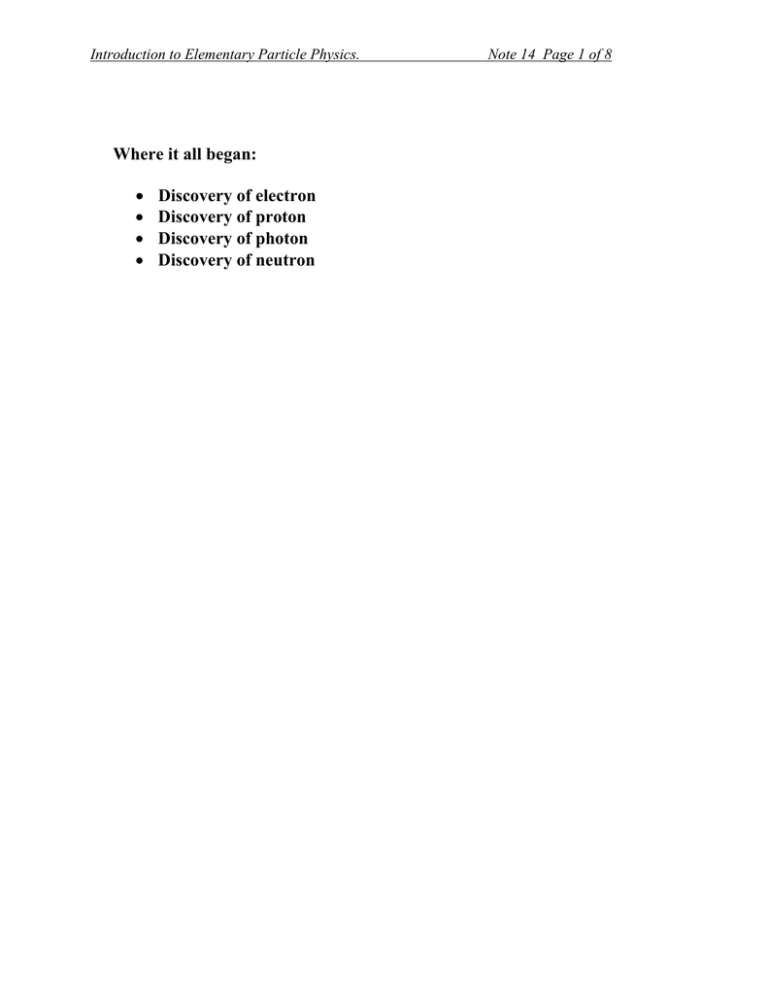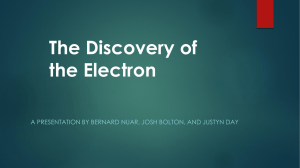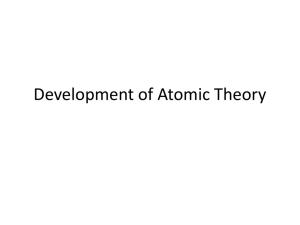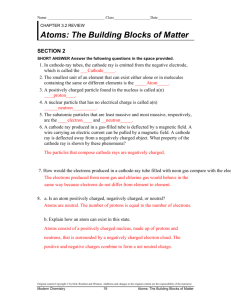Where it all began: Discovery of electron Discovery of proton
advertisement

Introduction to Elementary Particle Physics. Where it all began: • • • • Discovery of electron Discovery of proton Discovery of photon Discovery of neutron Note 14 Page 1 of 8 Introduction to Elementary Particle Physics. Note 14 Page 2 of 8 Introduction to Elementary Particle Physics. Note 14 Page 3 of 8 Discovery of electron 1709 Hauksbee: Glow in rarefied gas (p~1/60) vessels exposed to electric field (in contemporary terms) 1858 Geissler: Invents pump with mercury pistons: Æ p~10-4 1858-69 Plücker (Bonn) Æ No glowing in the gas, but there are glowing spots on glass next to cathode… Æ Rays can be deflected by magnetic filed Æ Rays can be blocked by solid objects (shadows) 1871 Varley: Speculates cathode rays are negatively charged small bits of matter (from deflection in magnetic field and direction of motion defined by shadows!) Goldstein Gives the name Cathodenstrahlen (cathode rays) Plücker: Rays are molecules of cathode material? Observed thin film of platinum on glass1… Crooks (English): Rays are gas molecules picked up negative charge from cathode? Goldstein Æ Rays cannot be molecules of any sort! He noted that cathode rays have range of 90 cm at p=10-5, while molecules—about 1 cm. 1883-91 Hertz (Berlin): * Cathode rays cannot be deflected by electric filed. (Now we know that the pressure was not low enough: ionized gas made E=0 inside tubes) * Cathode rays penetrate thin foils like light through glass: rays must be waves of some sort (deflectable by magnetic filed, though; hmm?) 1895 side note 1895 1896 1897 Perrin (French): used charge collector at the end of a glass tube to check if they have charge. Æ Rays do have negative charge! Röntgen (German): Becquerel (French): discovers X-rays (produced by cathode rays striking the glass wall…) discovers radioactivity (by searching for sunlight-induced X-rays…) J. J. Thomson (Professor of the Cavendish Lab at the University of Cambridge): Much better vacuum Æ first quantitative characteristics of rays: m/q-ratio l L (L>>l) Method A. By measuring deflections in B-fields and E-fields (this became possible due to much better vacuum): a. Deflection of cathode rays by magnetic field (3 unknowns in the equation, q, m, v): δB = b. Deflection of cathode rays by electric field (same 3 unknowns): δE = c. qvB l L ⋅ ⋅ m v v qE l L ⋅ ⋅ m v v Now with two equations, Thomson could extract m/q=1.3±0.3 × 10-11 kg/C (table 1) Method B. By trapping rays in a “charge collector” for about 1 second and measuring - accumulated charge, Q=qN (few μC) and - heat, H=½mv2⋅N (few degrees °C), In conjunction with one more equation relating q, m, v obtained in the measurements of deflection in magnetic field, this allowed to extract m/q ~0.5 × 10-11 kg/C (experimental range 0.4-1) Contemporary value of m/q=0.56857 × 10-11 kg/C 1 Now the effect is known as spluttering… Introduction to Elementary Particle Physics. Note 14 Page 4 of 8 1897 Townsend; Thomson, Wilson Indirect measurement of cathode ray charge assuming that molecule ions would have the same charge. Three independent and somewhat different experiments, but all used Wilson cloud chambers: - X-rays were used to ionize various gases. - Water droplets would condensate on ions and start falling. - The total charge Q and total mass M of all fallen droplets was measured. - Their number N was calculated from the total mass M and radius of droplets (the radius was estimated from the rate cloud was falling and using the Stockes’ Law: F=6πηRv). - This allowed to evaluate charge per droplet q=Q/N. The charge q was about the same in all 3 experiments ~1×10-19 C and for all gases used. Note: That was a measurement of an average charge and did not mean that the change was coming in quanta. The fact that charge indeed comes in quanta was experimentally established by Millikan (Chicago) in 1906. 1897 Zeeman and H.A.Lorentz: Zeeman effect (1896) and its classical explanation by Lorentz (1897) in terms of contraction and expansion of orbits of charged particles (assumed to be inside matter and responsible for light emission) gave about the same value m/q ratio as found by Thomson. 1899 Becquerel: β-rays have about the same m/q… 1899 Thomson: measure m/q for charged particles emitted in the photoelectric effect—same value… Thomson’s Conclusions (actually leap to conclusions in 1897): i. the ratio m/q seemed to be constant (independent of gas, cathode material, other experimental conditions; also, the particles manifested themselves outside and seemingly inside matter) ii. very small (penetrating!) and very light ( (m/q) was about 1000 time lighter than atom of hydrogen!) iii. Thomson states that electrons are present in all elements and, maybe, in very large quantities… Actually, the name electron (suggested earlier to describe amount of charge lost/acquired by atoms when they become ions) was attached to the new particles only about 10 years after Thomson’s experiments/conclusions. 1903 Thomson proposed a model, sometimes called the "plum pudding" or "raisin cake" model, in which thousands of tiny, negatively charged corpuscles swarm inside a sort of cloud of massless positive charge. A solar-system like structure proposed at the same time by Nagaoka (Japan) was heavily criticized as the electrons would lose their energy via electromagnetic radiation in <10-9 s. 1906 Thomson: Nobel Prize "in recognition of the great merits of his theoretical and experimental investigations on the conduction of electricity by gases" 1923 Millikan: Nobel Prize "for his work on the elementary charge of electricity and on the photoelectric effect" Introduction to Elementary Particle Physics. Note 14 Page 5 of 8 Discovery of proton 1896 Rutherford arrives to the Cavendish Lab from New Zeeland. Works on conductivity of gases exposed to X-rays and radioactivity, identifies α (short range) and β (large range) types of radioactivity 1898-1907 Rutherford studies radioactivity of U and Th (Montreal): 1. discovery of transmutation of elements Th(Thorium)ÆRn(Radon): Nobel Prize in 1908 together with Soddy 2. α-particles are He ions a. Invention of a proportional counter allowed Rutherford to count individual decays; in combination of the electrometer, he measured α-particle charge q=2e b. q/M from curvature of α-particle tracks in a cloud chamber placed in magnetic field 3. Curious observation: α-particles could be barely deflected by the strongest electric fields available the lab (vα~15,000 km/s!!!), while very thin sheets of mica made α-particle beam fuzzy Æ very strong electric fields inside matter? From studying αparticles to using them as a tool 1908-1910 Rutherford (Manchester) confirms using spectral analysis that α-particles are He. He starts studies (together with post-doc Geiger and student Mardsen) on scattering of α-particles by thin (a few hundreds of atoms) gold films and using scintillating screen (α-particles are used to probe the inner structure of an atom). They find α-particles bouncing right backward with a chance of 1/20,000 while the average scattering angle was θ~1°. Rutherford: “It was as though you had fired a 15-inch shell at a piece of tissue paper and it had bounced straight back and hit you”. Æ if the overall scattering were due to multiple micro-scatterings, scattering at >100° with the average of 1° is impossible (the central limit theorem) Æ if the overall scattering is a result of a single bounce, then the scattering core must be: a) very small (assuming electric nature of the scattering force) b) at least as heavy as α-particle c) One can convert the probability p=1/20,000 of bouncing back at >90° into a measurement of Z and r (show how). Rutherford’s result was Z~200 and r<10-13 m (Z=97 for gold) This is the discovery of the atom nucleus! Uniformly distributed positive charge of Q = Ze and radius r has potential at its center 1Q 3Q Q ϕ= k + k= k 2 r 2 r r An α -particle (q = 2e, kinetic energy E = 0.1 MeV) can bounce back only if ⎛3Q ⎞ E<⎜ k ⎟ q, or: ⎝2 r ⎠ 3Qqk ~ 6 Z × 10−16 m, r< 2E which implies, even for Z~100, a tiny nucleus 1000 times (!!!) smaller than the size of an atom ~ 10−10 m 1913 Atom model changes, supported by Bohr’s idea of electrons orbiting the atom nucleus, while their momenta allowed taking only integral numbers of ħ-quanta… 1913 Moseley (Manchester) measures wavelength of X-rays for elements Calcium to Zinc (Z=20-30). Using Bohr’s formula, he shows that charge for their nuclei must be 20.00e, … 29.01e, 30.01e (see table 3). Introduction to Elementary Particle Physics. Note 14 Page 6 of 8 1910-1914 Rutherford and Mardsen study α-particle scattering by light elements in hope to get deeper inside the nucleus (smaller Z): 1. They use a cloud chamber (Wilson) filled with Hydrogen: while α-particles have pretty much fixed range, Rutherford and Mardsen occasionally observe tracks up to 4 times longer (either 4 times larger energy or 2 times smaller charge). They introduce notion of H-particles and speculate that they are nuclei of Hydrogen knocked out from atoms by α-particles. These became to be known as protons. 2. Mardsen observes similar H-particles in an air-filled cloud chamber (did not have a chance to pursue further) 1914-1917 World War I disrupts research in Europe, Mardsen moves to New Zeland. 1917-1919 Rutherford comes back to H-particles: he uses α-particles to bombard B, F, Na, Al, P, and N and sees H-particles kicked off from all of them. The H-particles, protons, must be constituents of all elements. Æ This conclusion (and experiments it is based on) may be considered the discovery of a new elementary particle, proton, in addition to an electron 1919 Rutherford comes back to the Cavendish lab as the Cavendish Lab Professor. 1920 Rutherford proposes a new particle neutron and his model of nucleus: element N is composed of N protons and ~N neutrons needed to beef up the mass without adding the charge. However, the idea is not well received: - it required a new particles - the alternative model of 2N protons and N electrons seemed to be more in line with β-radioactivity 1908 Rutherford and Soddy are awarded the Nobel Prize for discovery of element transmutations Introduction to Elementary Particle Physics. Note 14 Page 7 of 8 Discovery of photon 1900 Planck explains the black body emission spectrum by assuming that the energy can be irradiated in quanta proportional to the electromagnetic wave frequency: hν 1905 Einstein explains the fact that photoeffect onset depends not on the intensity of light irradiation, but rather on its frequency and relates that to the energy carried by light quanta: E=hν 1923 Compton experiment of measuring the wavelength of scattered X-rays: From the classical Maxwell’s wave theory, an incident electromagnetic wave of frequency ν should cause electrons oscillate at the same frequency and re-emit waves in all directions (actually, dipole-like) again at the same frequency ν. The observed effect was different: the larger the angle of scattering, the longer wavelength of reemitted rays was… The shift in the frequency of light scattered by electrons, Δλ=λα(1-cosθ), and the energy transferred to electrons, however, could be easily accounted for by assuming that light is composed of particles with energy E=hν, momentum p=hν/c, and mass m=0. 1917 1921 1927 Planck is awarded the Nobel Prize: Einstein is awarded the Nobel Prize: Compton is awarded the Nobel Prize: Introduction to Elementary Particle Physics. Note 14 Page 8 of 8 Discovery of neutron 1920s Chadwick had a few unsuccessful attempts to find neutrons suggested by Rutherford… Problem with Nitrogen nucleus spin: 2n=14 protons and n=7 electrons should make it half-integer, while it was known to be 1 (structure of spectral lines in N2). Note that O with Z=6 did not have the same problem. 1930 Bothe and Becker bombard Beryllium Be9 with α-particles and find extremely penetrating radiation. γ? 1932 Joliot-Curie family (Irene Curie is the daughter of Pierre and Mary Curie) confirms the same radiation. They also observe that the radiation effectively knocks off protons from wax—the strange thing was in how readily this was happening for such heavy particles as protons). 1932 Chadwick at the Cavendish Lab realizes right away that the new radiation looked like neutrons. He carries out a series of experiments with a cloud chamber filled with different gases, H, He, N, Ar and with different windows, Li, Be, C. He exposes the chamber to the new radiation particles and observes the range of recoiling nuclei. From the large range of the recoils (even for heavy elements), the new radiation could not be explained as gammas, but would be consistent with a hypothesis of a particle having the mass equal to the mass of a proton. It is the neutron! The maximum energy a photon of energy ε can transfer to a particle of mass M : 1 2ε E= ⋅ε = ⋅ε M M 1+ 2ε The maximum energy a particle of mass m and energy ε can transfer to a particle of mass M : 4mM E= ⋅ε (m + M ) 2 This requires a) 50 MeV photons to make H-recoils with the observed energy E=5 MeV, but b) the heavier elements then would have way too little energy to account for the level of ionization in the ionization chamber… c) Also, 50 MeV is too large, >> energy of initial α-particles (*) Neutrons with a mass equal to the proton mass, on the other hand, need only 5 MeV to generate 5 MeV protons... (*) The energy of neutrons was coming out just right from mass defect calculations: α+Be9 Æ C13 + n: ε=5 MeV! (*) The energy transmitted to heavier elements was also in a good agreement with the data, assuming that the radiation was made of 5 MeV neutrons (m=1 GeV). Note that once both formulas above are tuned to reproduce results for H-recoils, they differ by a factor of 4 for elements with M>>m, 1935 Chadwick receives Nobel Prize for discovering neutron







